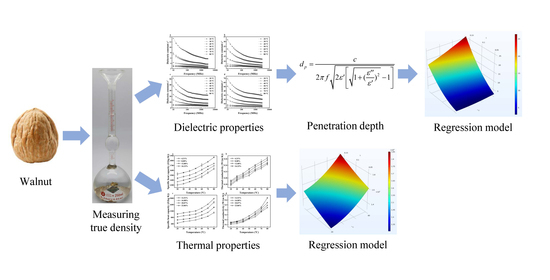Temperature and Moisture Dependent Dielectric and Thermal Properties of Walnut Components Associated with Radio Frequency and Microwave Pasteurization
Abstract
:1. Introduction
2. Materials and Methods
2.1. Materials and Sample Preparation
2.2. Measurements of Moisture Content and True Density
2.3. Measurements of Dielectric Properties
2.4. Measurements of Thermal Properties
2.5. Determination of Penetration Depth
2.6. Statistical Analysis
3. Results and Discussion
3.1. True Density
3.2. Frequency-Dependent Dielectric Properties
3.3. Moisture and Temperature-Dependent Dielectric Properties
3.4. Regression Models for Dielectric Properties
3.5. Penetration Depth
3.6. Moisture and Temperature-Dependent Thermal Properties
4. Conclusions
Author Contributions
Funding
Data Availability Statement
Acknowledgments
Conflicts of Interest
References
- FAOSTAT. Food and Agriculture Organization of the United States. 2022. Available online: https://www.fao.org/faostat/en/#data/QCL (accessed on 5 February 2022).
- Davidson, G.R.; Frelka, J.C.; Yang, M.; Jones, T.M.; Harris, L.J. Prevalence of Escherichia coli O157:H7 and Salmonella on inshell California walnuts. J. Food Prot. 2015, 78, 1547–1553. [Google Scholar] [CrossRef] [PubMed]
- Zhang, L.; Wang, S. Bacterial community diversity on in-shell walnut surfaces from six representative provinces in China. Sci. Rep. 2017, 7, 10054. [Google Scholar] [CrossRef] [PubMed] [Green Version]
- Singh, P.K.; Shukla, A.N. Survey of mycoflora counts, aflatoxin production biochemical changes in walnut kernels. J. Stored Prod. Res. 2008, 44, 169–172. [Google Scholar] [CrossRef]
- Frelka, J.C.; Harris, L.J. Evaluation of microbial loads and the effects of antimicrobial sprays in postharvest handling of California walnuts. Food Microbiol. 2015, 48, 133–142. [Google Scholar] [CrossRef]
- Fan, X.; Annous, B.A.; Beaulieu, J.C.; Sites, J.E. Effect of hot water surface pasteurization of whole fruit on shelf life and quality of fresh-cut cantaloupe. J. Food Sci. 2008, 73, M91–M98. [Google Scholar] [CrossRef]
- Chang, S.S.; Han, A.R.; Reyes-De-Corcuera, J.I.; Powers, J.R.; Kang, D.H. Evaluation of steam pasteurization in controlling Salmonella serotype Enteritidis on raw almond surfaces. Lett. Appl. Microbiol. 2010, 50, 393–398. [Google Scholar] [CrossRef]
- Altemimi, A.; Aziz, S.N.; Al-Hilphy, A.R.S.; Lakhssassi, N.; Watson, D.G.; Ibrahim, S.A. Critical review of radio-frequency (RF) heating applications in food processing. Food Qual. Saf. 2019, 3, 81–91. [Google Scholar] [CrossRef]
- Chen, L.; Jung, J.; Chaves, B.D.; Jones, D.; Subbiah, J. Challenges of dry hazelnut shell surface for radio frequency pasteurization of inshell hazelnuts. Food Control 2021, 125, 107948. [Google Scholar] [CrossRef]
- Qu, Z.; Tang, Z.W.; Liu, F.; Sablani, S.S.; Ross, C.F.; Sankaran, S.; Tang, J.M. Quality of green beans (Phaseolus vulgaris L.) influenced by microwave and hot water pasteurization. Food Control 2021, 124, 107936. [Google Scholar] [CrossRef]
- Zhang, L.; Lyng, J.G.; Xu, R.; Zhang, S.; Zhou, X.; Wang, S. Influence of radio frequency treatment on in-shell walnut quality and Staphylococcus aureus ATCC 25923 survival. Food Control 2019, 102, 197–205. [Google Scholar] [CrossRef]
- Shirkolea, S.S.; Mujumdar, A.S.; Jayabalan, R.; Sutar, P.P. Dry pasteurization of paprika (Capsicum annuum L.) by short time intensive microwave-infrared radiation: Inactivation of Salmonella Typhimurium and Aspergillus flavus considering quality degradation kinetics. Food Chem. 2021, 338, 128012. [Google Scholar] [CrossRef] [PubMed]
- Komarov, V.V. A review of radio frequency and microwave sustainability-oriented technologies. Sustain. Mater. Technol. 2021, 28, e00234. [Google Scholar] [CrossRef]
- Jiang, H.; Liu, Z.; Wang, S. Microwave processing: Effects and impacts on food components. Crit. Rev. Food Sci. Nutr. 2018, 58, 2476–2489. [Google Scholar] [CrossRef] [PubMed]
- Mukama, M.; Ambaw, A.; Opara, U.L. Thermophysical properties of fruit-a review with reference to postharvest handling. J. Food Meas. Charact. 2020, 14, 2917–2937. [Google Scholar] [CrossRef]
- Sosa-Morales, M.E.; Valerio-Junco, L.; Lopez-Malo, A.; Garcia, H.S. Dielectric properties of foods: Reported data in the 21st Century and their potential applications. LWT-Food Sci. Technol. 2010, 43, 1169–1179. [Google Scholar] [CrossRef]
- Bon, J.; Vaquiro, H.; Benedito, J.; Telis-Romero, J. Thermophysical properties of mango pulp (Mangifera indica L. cv. Tommy Atkins). J. Food Eng. 2010, 97, 563–568. [Google Scholar] [CrossRef]
- Chen, Y.; He, J.; Li, F.; Tang, J.; Jiao, Y. Model food development for tuna (Thunnus Obesus) in radio frequency and microwave tempering using grass carp mince. J. Food Eng. 2021, 292, 110267. [Google Scholar] [CrossRef]
- Evangelista, R.R.; Sanches, M.A.R.; de Castilhos, M.B.M.; Cantu-Lozano, D.; Telis-Romero, J. Determination of the rheological behavior and thermophysical properties of malbec grape juice concentrates (Vitis vinifera). Food Res. Int. 2020, 137, 109431. [Google Scholar] [CrossRef]
- Taheri, S.; Brodie, G.; Jacob, M.V.; Antunes, E. Dielectric properties of chickpea, red and green lentil in the microwave frequency range as a function of temperature and moisture content. J. Microw. Power. Electromagn. Energy 2018, 52, 198–214. [Google Scholar] [CrossRef]
- Zhu, X.; Guo, W.; Wang, S. Dielectric properties of ground hazelnuts at different frequencies, temperatures, and moisture contents. Trans. ASABE 2014, 57, 161–168. [Google Scholar]
- Boldor, D.; Sanders, T.H.; Simunovic, J. Dielectric properties of in-shell and shelled peanuts at microwave frequencies. Trans. ASAE 2004, 47, 1159–1169. [Google Scholar] [CrossRef]
- Huang, Z.; Zhang, B.; Marra, F.; Wang, S. Computational modelling of the impact of polystyrene containers on radio frequency heating uniformity improvement for dried soybeans. Innov. Food Sci. Emerg. Technol. 2016, 33, 365–380. [Google Scholar] [CrossRef]
- Perussello, C.A.; Mariani, V.C.; Camargo do Amarante, A.C. Thermophysical properties of okara during drying. Int. J. Food Prop. 2014, 17, 891–907. [Google Scholar] [CrossRef]
- Rusu, M.E.; Gheldiu, A.-M.; Mocan, A.; Vlase, L.; Popa, D.-S. Anti-aging potential of tree nuts with a focus on the phytochemical composition, molecular mechanisms and thermal stability of major bioactive compounds. Food Funct. 2018, 9, 2554–2575. [Google Scholar] [CrossRef] [PubMed]
- Zheng, D.; Zhang, Y.; Guo, Y.; Yue, J. Isolation and Characterization of Nanocellulose with a Novel Shape from Walnut (Juglans Regia L.) Shell Agricultural Waste. Polymers 2019, 11, 1130. [Google Scholar] [CrossRef] [PubMed] [Green Version]
- Wang, S.; Tang, J.; Johnson, J.A.; Mitcham, E.; Hansen, J.D.; Hallman, G.; Drake, S.R.; Wang, Y. Dielectric properties of fruits and insect pests as related to radio frequency and microwave treatments. Biosyst. Eng. 2003, 85, 201–212. [Google Scholar] [CrossRef]
- Mao, Y.; Wang, P.; Wu, Y.; Hou, L.; Wang, S. Effects of various radio frequencies on combined drying and disinfestation treatments for in-shell walnuts. LWT-Food Sci. Technol. 2021, 144, 111246. [Google Scholar] [CrossRef]
- Kader, A.A. Impact of nut postharvest handling, de-shelling, drying and storage on quality. In Improving the Safety and Quality of Nuts; Harris, L.J., Ed.; Woodhead Publishing Limited: Cambridge, MA, USA, 2013; Volume 250, pp. 22–34. [Google Scholar]
- AOAC. Official Methods of Analysis of the Association of Official Analytical Chemists; AOAC: Rockville, MD, USA, 2002. [Google Scholar]
- Guo, W.; Tiwari, G.; Tang, J.; Wang, S. Frequency, moisture and temperature-dependent dielectric properties of chickpea flour. Biosyst. Eng. 2008, 101, 217–224. [Google Scholar] [CrossRef]
- Li, R.; Zhang, S.; Kou, X.; Ling, B.; Wang, S. Dielectric properties of almond kernels associated with radio frequency and microwave pasteurization. Sci. Rep. 2017, 7, 42452. [Google Scholar] [CrossRef] [Green Version]
- Jiao, Y.; Tang, J.; Wang, Y.; Koral, T.L. Radio-frequency applications for food processing and safety. Annu. Rev. Food Sci. Technol. 2018, 9, 105–127. [Google Scholar] [CrossRef] [Green Version]
- Aydin, C. Physical properties of hazel nuts. Biosyst. Eng. 2002, 82, 297–303. [Google Scholar] [CrossRef]
- Altuntas, E.; Erkol, M. Physical properties of shelled and kernel walnuts as affected by the moisture content. Czech J. Food Sci. 2010, 28, 547–556. [Google Scholar] [CrossRef] [Green Version]
- Feng, H.; Tang, J.; Cavalieri, R.P. Dielectric properties of dehydrated apples as affected by moisture and temperature. Trans. ASAE 2002, 45, 129–135. [Google Scholar] [CrossRef] [Green Version]
- Liu, Y.; Yang, M.; Gao, Y.; Fan, X.; Zhao, K. Broadband dielectric properties of honey: Effects of temperature. J. Food Sci. Technol. 2020, 57, 1656–1660. [Google Scholar] [CrossRef]
- Gezahegn, Y.A.; Tang, J.; Sablani, S.S.; Pedrow, P.D.; Hong, Y.K.; Lin, H.; Tang, Z. Dielectric properties of water relevant to microwave assisted thermal pasteurization and sterilization of packaged foods. Innov. Food Sci. Emerg. Technol. 2021, 74, 102837. [Google Scholar] [CrossRef]
- Qi, S.; Han, J.; Lagnika, C.; Jiang, N.; Zhang, M. Dielectric properties of edible fungi powder related to radio-frequency and microwave drying. Food Prod. Process. Nutr. 2021, 3, 15. [Google Scholar] [CrossRef]
- Xie, W.; Chen, P.; Wang, F.; Li, X.; Wei, S.; Jiang, Y.; Liu, Y.; Yang, D. Dielectric properties of Camellia oleifera seed kernels related to microwave and radio frequency drying. Int. Food Res. J. 2019, 26, 1577–1585. [Google Scholar]
- Zhou, X.; Li, R.; Lyng, J.G.; Wang, S. Dielectric properties of kiwifruit associated with a combined radio frequency vacuum and osmotic drying. J. Food Eng. 2018, 239, 72–82. [Google Scholar] [CrossRef]
- Cao, H.; Fan, D.; Jiao, X.; Huang, J.; Zhao, J.; Yan, B.; Zhou, W.; Zhang, W.; Zhang, H. Heating surimi products using microwave combined with steam methods: Study on energy saving and quality. Innov. Food Sci. Emerg. Technol. 2018, 47, 231–240. [Google Scholar] [CrossRef]
- Jiang, N.; Liu, C.; Li, D.; Lagnika, C.; Zhang, Z.; Huang, J.; Liu, C.; Zhang, M.; Yu, Z. Dielectric properties of Agaricus bisporus slices relevant to drying with microwave energy. Int. J. Food Prop. 2020, 23, 354–367. [Google Scholar] [CrossRef] [Green Version]
- Yu, D.U.; Shrestha, B.L.; Baik, O.D. Radio frequency dielectric properties of bulk canola seeds under different temperatures, moisture contents, and frequencies for feasibility of radio frequency disinfestation. Int. J. Food Prop. 2015, 18, 2746–2763. [Google Scholar] [CrossRef]
- Oriola, K.O.; Hussein, J.B.; Oke, M.O.; Ajetunmobi, A. Description and evaluation of physical and moisture-dependent thermal properties of jack bean seeds (Canavalia ensiformis). J. Food Process. Pres. 2021, 45, e15166. [Google Scholar] [CrossRef]
- Aviara, N.A.; Haque, M.A. Moisture dependence of thermal properties of sheanut kernel. J. Food Eng. 2001, 47, 109–113. [Google Scholar] [CrossRef]
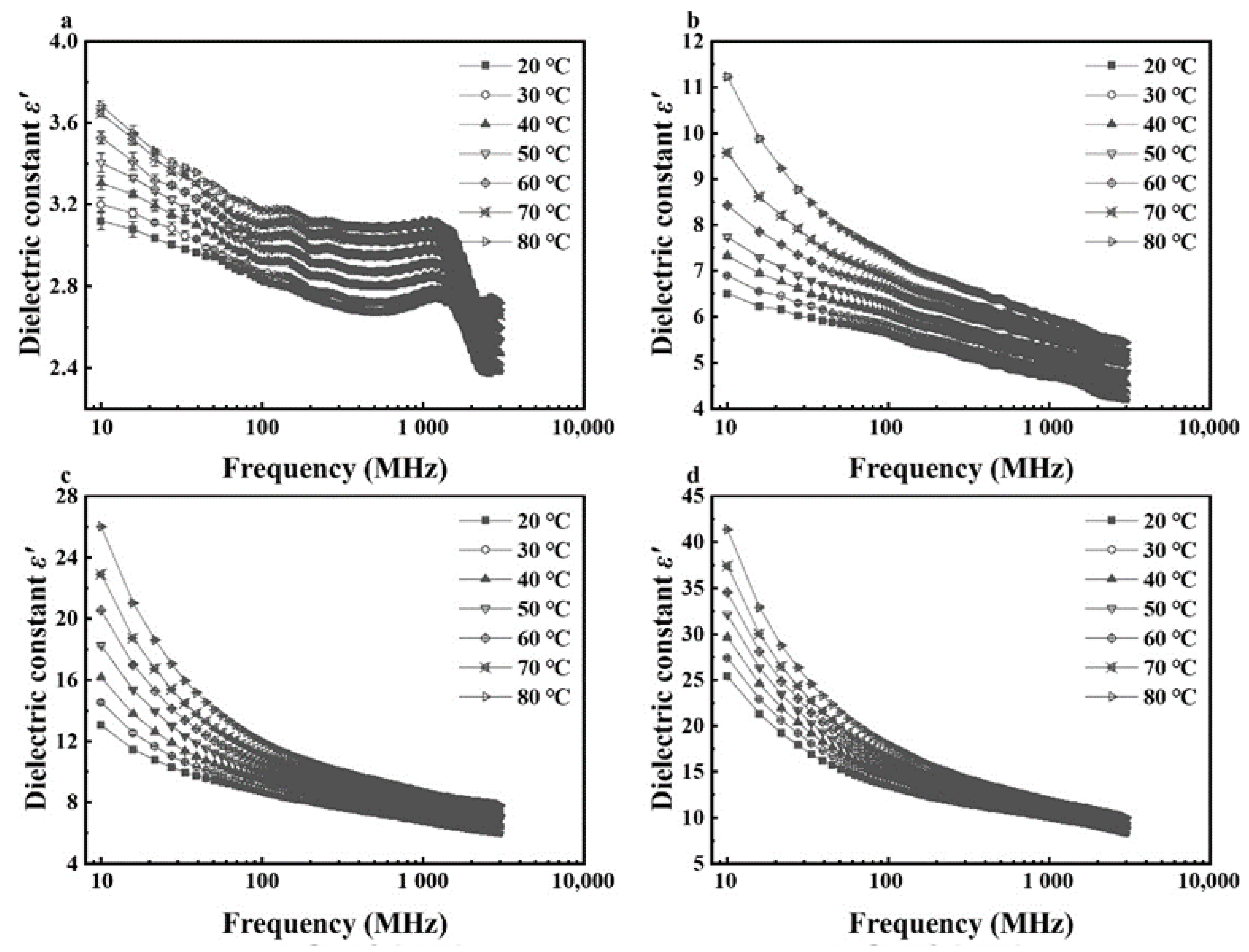
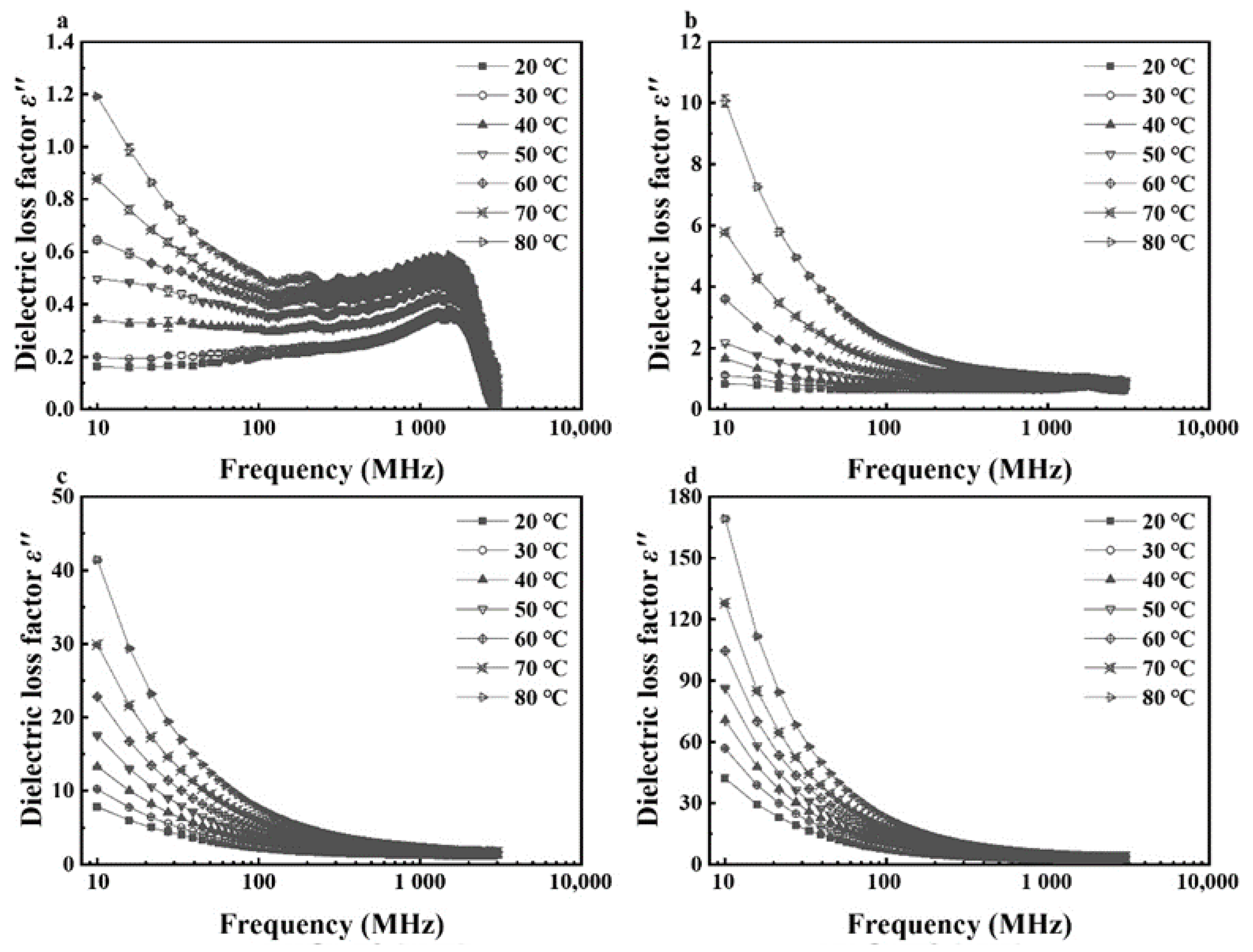
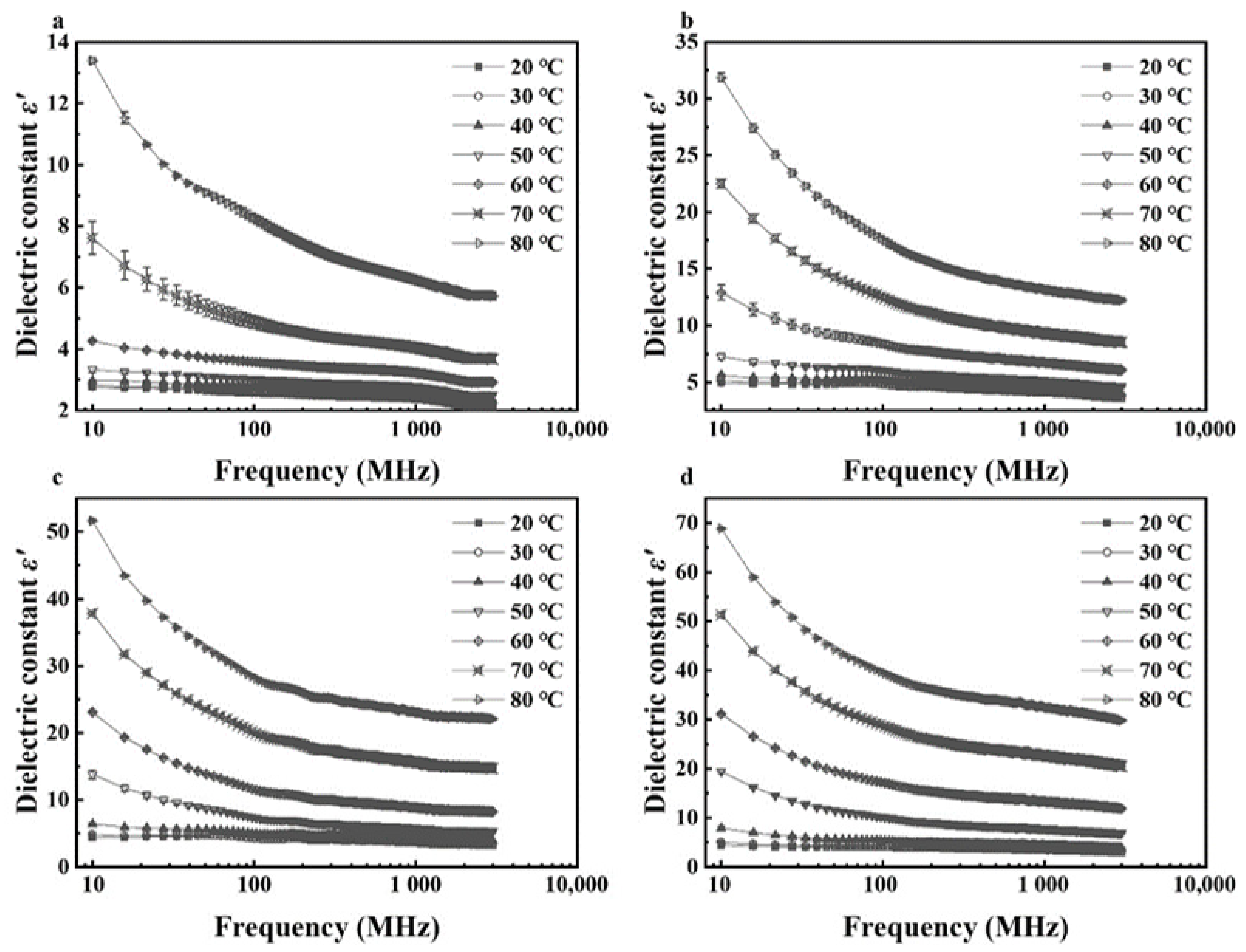
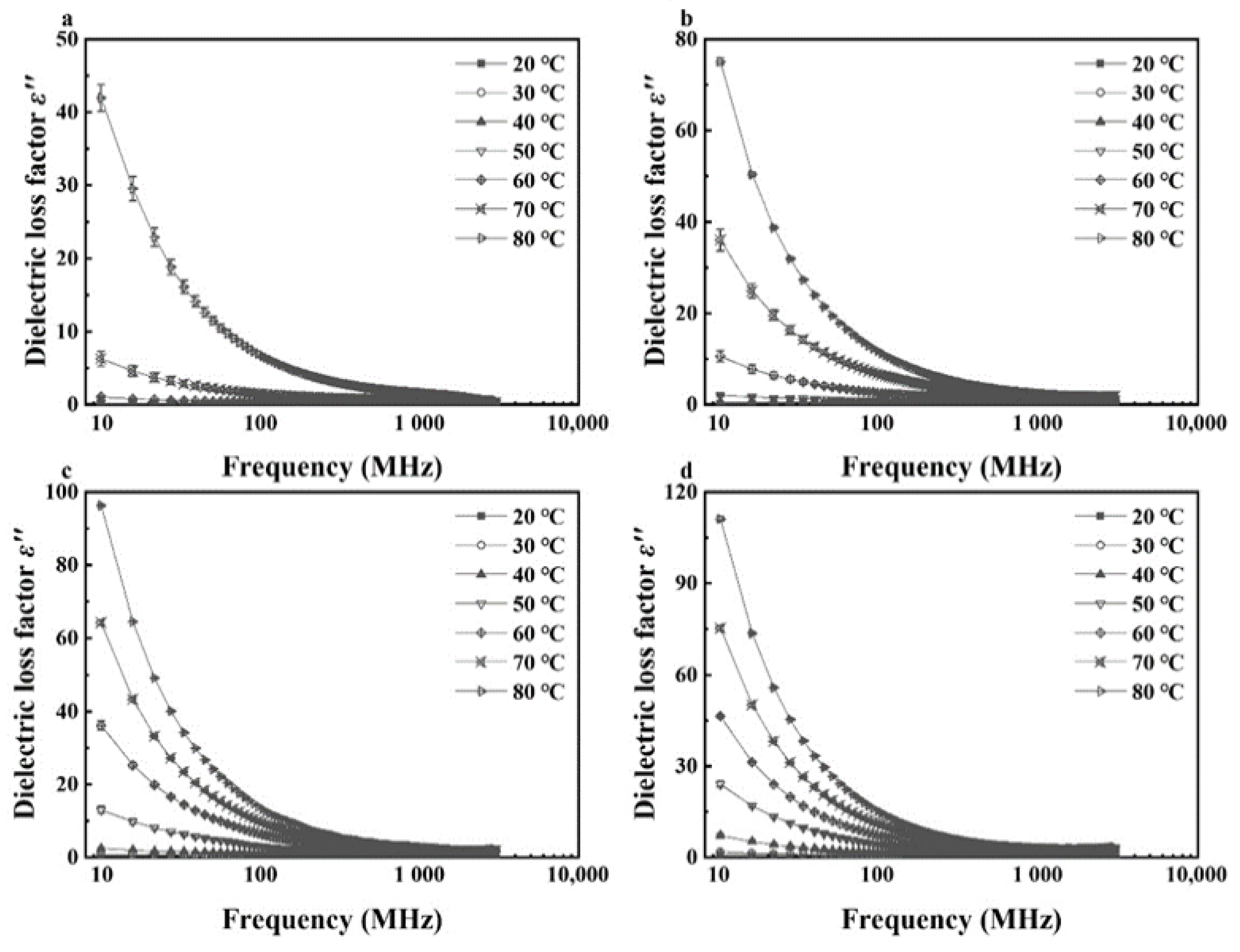
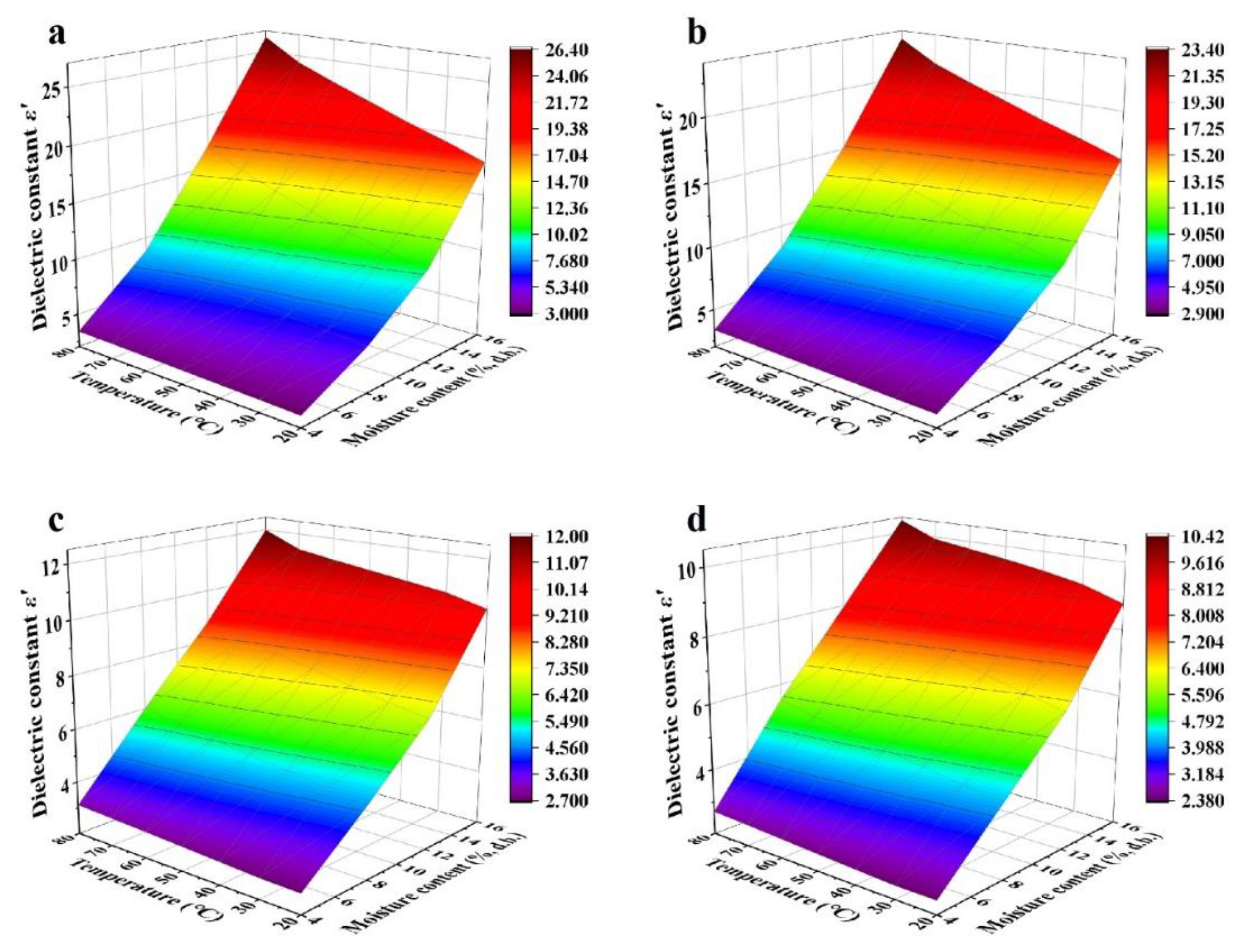
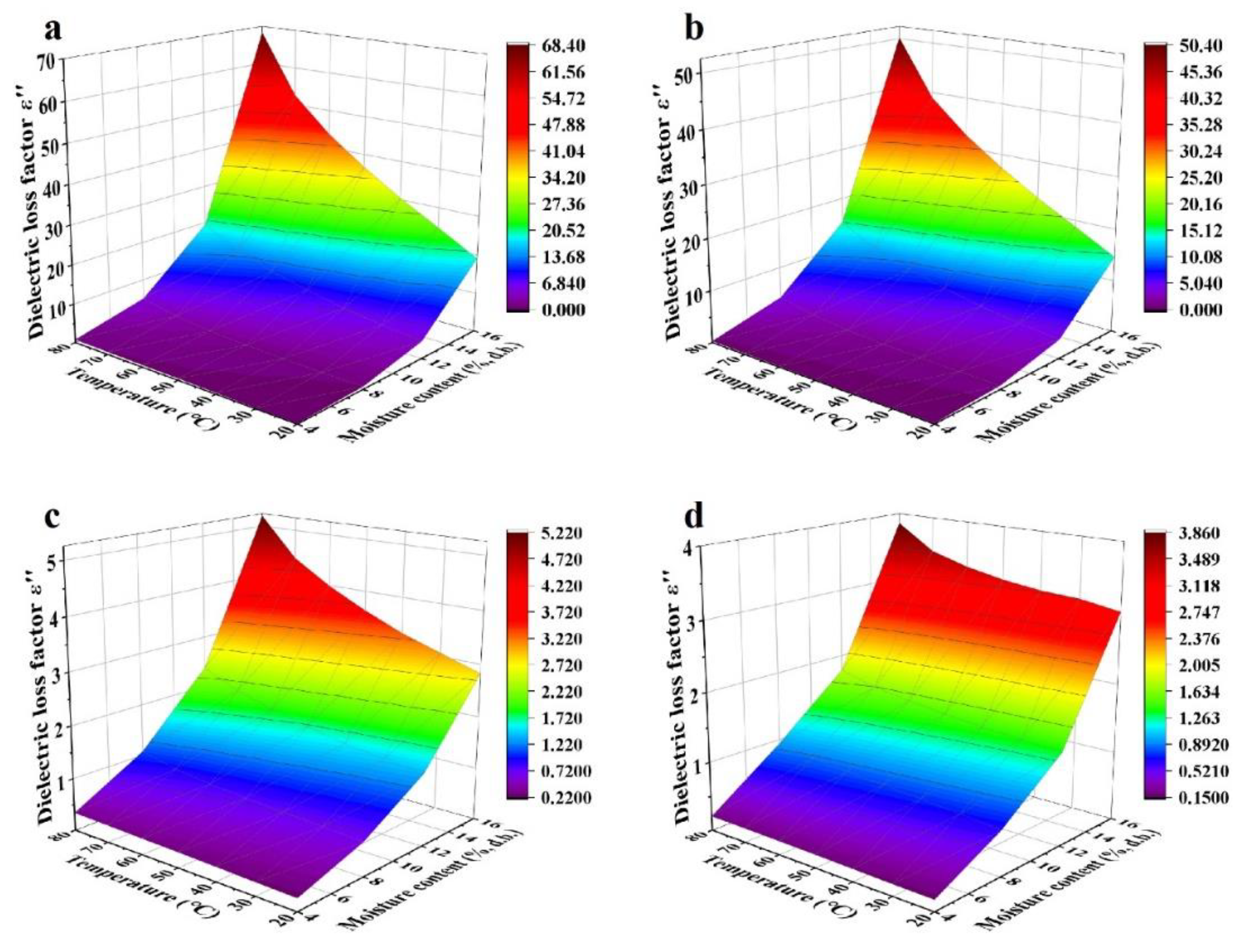
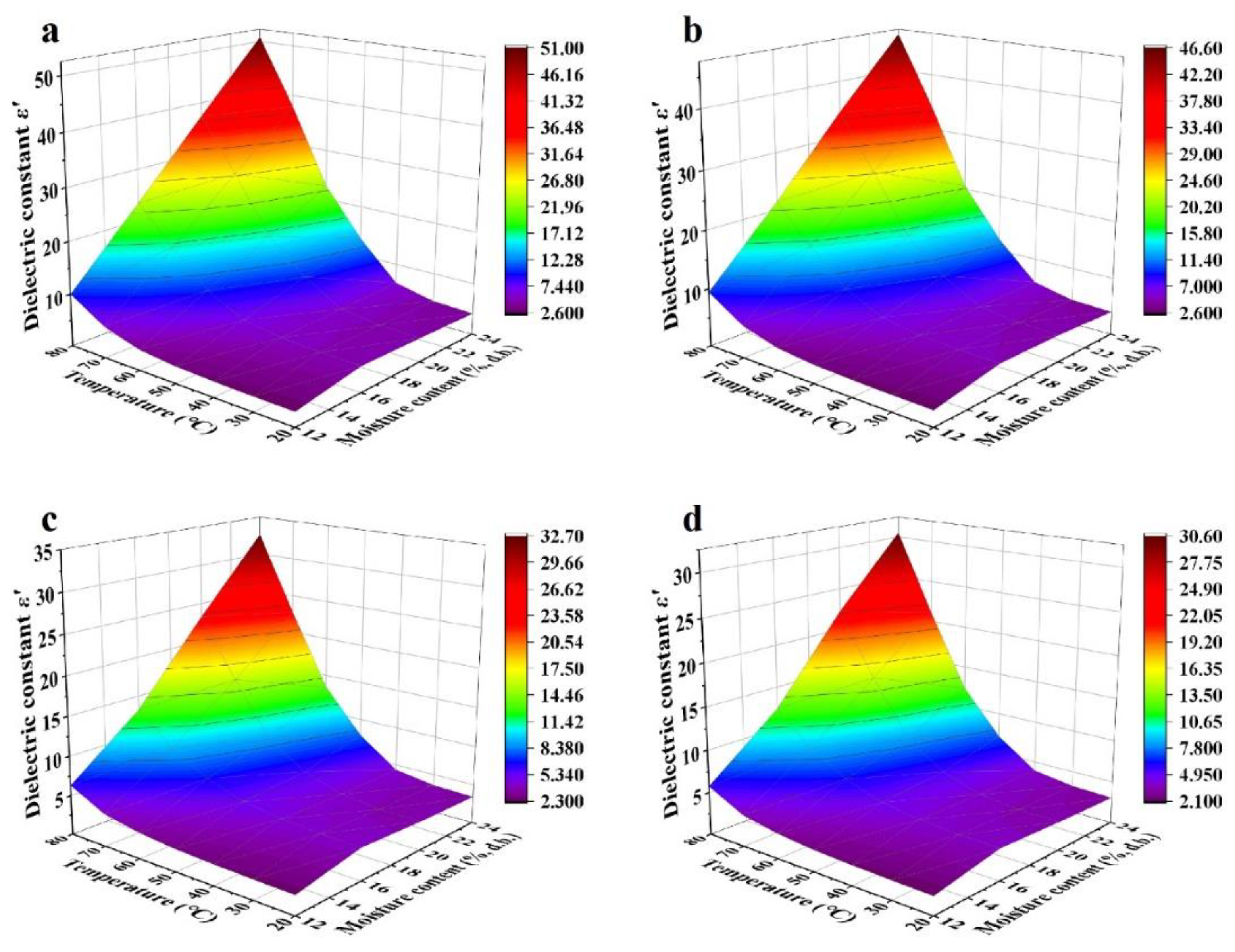

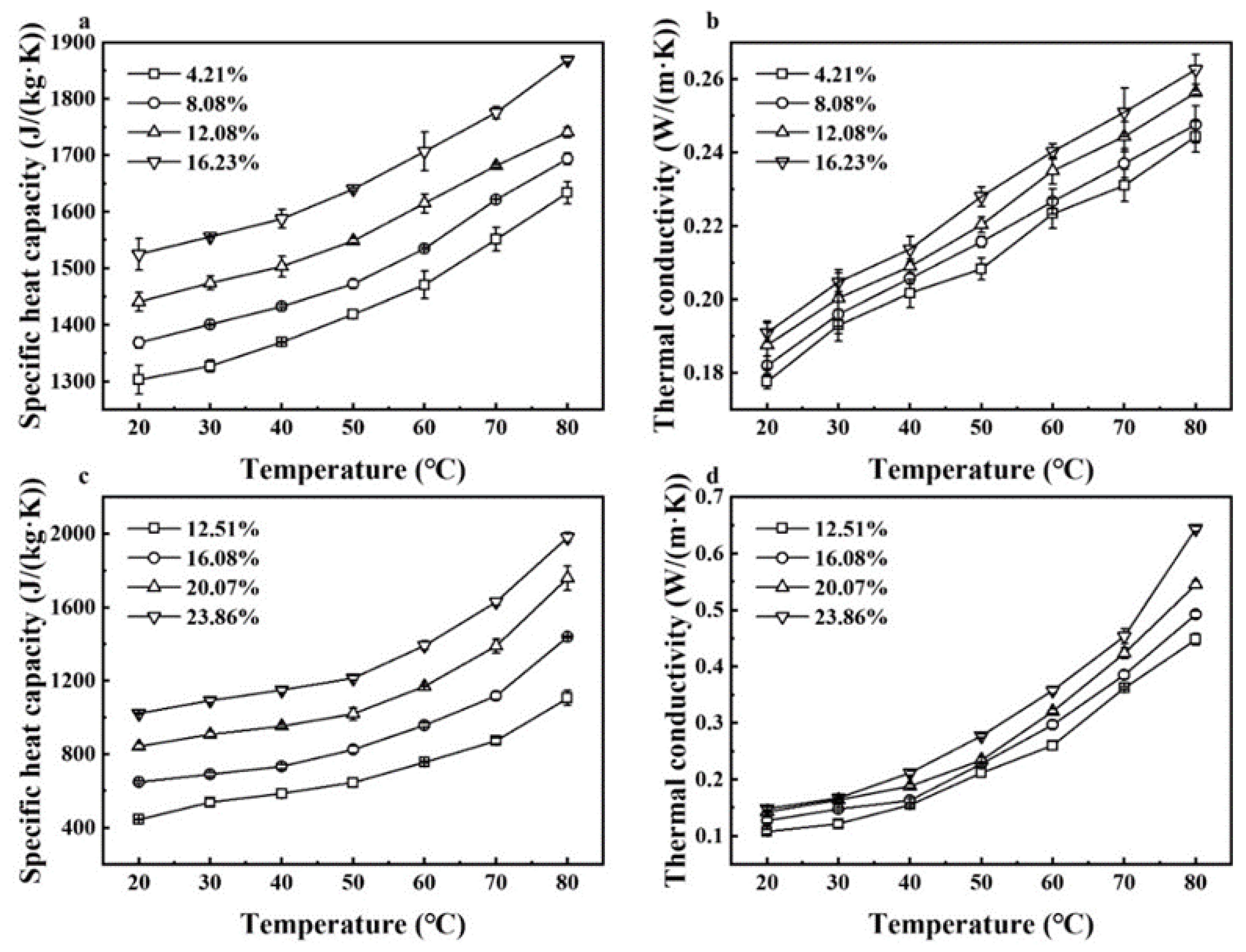
| Moisture Content (%, d.b.) | True Density (g/cm3) | |
|---|---|---|
| Kernel | 4.21 | 1.019 ± 0.006 a |
| 8.08 | 1.012 ± 0.004 a b | |
| 12.08 | 1.007 ± 0.003 b | |
| 16.23 | 1.003 ± 0.003 b | |
| Shell | 12.51 | 0.988 ± 0.023 c |
| 16.08 | 1.021 ± 0.015 b c | |
| 20.07 | 1.045 ± 0.006 a b | |
| 23.86 | 1.067 ± 0.007 a | |
| Frequency (MHz) | Material | Dielectric Properties | R2 |
|---|---|---|---|
| 27 | Kernel | ε′ = 4.24 − 8.78 × 10−2 T − 0.37 M + 1.14 × 10−2 TM + 4.68 × 10−4 T2 + 6.62 × 10−2 M2 | 0.999 |
| ε″ = −34.17 + 1.10 T + 9.48 M − 0.15 TM − 1.47 × 10−2 T2 − 0.95 M2 + 6.58 × 10−4 T2 M + 7.20 × 10−3 TM2 + 7.51 × 10−5 T3 + 3.31 × 10−2 M3 | 0.997 | ||
| Shell | ε’ = −46.15 + 0.61 T + 7.64 M − 7.18 × 10−2 TM − 1.20 × 10−2 T2 − 0.34 M2 + 1.08 × 10−3 T2 M + 6.95 × 10−4 TM2 + 1.64 × 10−5 T3 + 5.23 × 10−3 M3 | 0.996 | |
| ε″ = 21.36 − 1.70 T + 0.31 M + 4.65 × 10−2 TM + 1.38 × 10−2 T2 − 4.06 × 10−2 M2 | 0.974 | ||
| 40 | Kernel | ε′ = 3.52 − 7.32 × 10−2 T − 0.17 M + 9.37 × 10−3 TM + 3.98 × 10−4 T2 + 5.19 × 10−2 M2 | 0.999 |
| ε″ = −23.27 + 0.75 T + 6.51 M − 0.10 TM − 1.03 × 10−2 T2 − 0.66 M2 + 4.63 × 10−4 T2 M + 4.95 × 10−3 TM2 + 5.31 × 10−5 T3 + 2.33 × 10−2 M3 | 0.998 | ||
| Shell | ε’ = −43.54 + 0.72 T + 6.81 M − 7.53 × 10−2 TM − 1.29 × 10−2 T2 − 0.29 M2 + 1.03 × 10−3 T2 M + 7.79 × 10−4 TM2 + 2.35 × 10−5 T3 + 4.09 × 10−3 M3 | 0.996 | |
| ε″ = 12.60 − 1.23 T + 0.55 M + 3.39 × 10−2 TM + 1.01 × 10−2 T2 − 3.79 × 10−2 M2 | 0.974 | ||
| 915 | Kernel | ε’ = 0.19 + 7.10 × 10−3 T + 0.59 M + 7.12 × 10−2 TM − 6.19 × 10−4 T2 − 3.09 × 10−2 M2 + 1.00 × 10−5 T2 M − 3.12 × 10−4 TM2 + 3.93 × 10−6 T3 + 1.85 × 10−3 M3 | 1.000 |
| ε″ = −1.39 + 4.78 × 10−2 T + 0.40 M − 5.72 × 10−3 TM − 6.89 × 10−4 T2 − 3.26 × 10−2 M2 + 3.68 × 10−5 T2 M + 2.44 × 10−4 TM2 + 3.36 × 10−6 T3 + 1.39 × 10−3 M3 | 0.999 | ||
| Shell | ε’ = −61.30 + 1.27 T + 8.64 M − 9.72 × 10−2 TM − 1.73 × 10−2 T2 − 0.37 M2 + 8.86 × 10−4 T2 M + 1.28 × 10−3 TM2 + 5.06 × 10−5 T3 + 5.61 × 10−3 M3 | 0.997 | |
| ε″ = −0.96 − 7.15 × 10−2 T + 0.25 M + 2.30 × 10−2 TM + 6.37 × 10−4 T2 − 7.64 × 10−3 M2 | 0.967 | ||
| 2450 | Kernel | ε′ = 0.28 − 1.10 × 10−2 T + 0.51 M + 8.95 × 10−3 TM − 3.94 × 10−4 T2 − 2.43 × 10−2 M2 − 3.77 × 10−6 T2 M − 3.40 × 10−4 TM2 + 3.07 × 10−6 T3 + 1.38 × 10−3 M3 | 1.000 |
| ε″ = −1.72 + 2.90 × 10−2 T + 0.55 M − 1.60 × 10−3 TM − 5.17 × 10−4 T2 − 5.33 × 10−2 M2 + 2.09 × 10−5 T2 M + 2.01 × 10−5 TM2 + 2.61 × 10−6 T3 + 2.29 × 10−3 M3 | 0.999 | ||
| Shell | ε’ = −49.63 + 1.20 T + 6.66 M − 8.69 × 10−2 TM − 1.72 × 10−2 T2 − 0.27 M2 + 8.49 × 10−4 T2 M + 1.04 × 10−3 TM2 + 5.25 × 10−5 T3 + 3.89 × 10−3 M3 | 0.996 | |
| ε″ = −22.15 − 7.87 × 10−2 T + 3.98 M + 1.48 × 10−3 TM + 1.06 × 10−3 T2 − 0.22 M2 + 1.32 × 10−5 T2 M − 5.48 × 10−6 TM2 − 6.34 × 10−6 T3 + 3.94 × 10−3 M3 | 0.976 |
| Moisture Content (%, d.b.) | Temperature (°C) | Penetration Depth (cm) | |||
|---|---|---|---|---|---|
| 27 MHz | 40 MHz | 915 MHz | 2450 MHz | ||
| 4.21 | 20 | 1845.75 ± 108.31 | 1239.87 ± 73.91 | 27.59 ± 0.25 | 25.19 ± 0.04 |
| 40 | 973.10 ± 73.58 | 645.63 ± 25.26 | 22.83 ± 0.01 | 16.43 ± 0.02 | |
| 60 | 604.89 ± 10.65 | 427.63 ± 2.83 | 18.89 ± 0.02 | 11.62 ± 0.01 | |
| 80 | 421.55 ± 5.41 | 325.36 ± 2.97 | 17.29 ± 0.02 | 10.37 ± 0.01 | |
| 8.08 | 20 | 656.77 ± 44.57 | 424.37 ± 4.06 | 17.75 ± 0.07 | 6.29 ± 0.03 |
| 40 | 435.42 ± 7.87 | 315.57 ± 6.41 | 16.39 ± 0.03 | 5.69 ± 0.00 | |
| 60 | 243.21 ± 5.65 | 188.68 ± 3.42 | 14.81 ± 0.05 | 5.38 ± 0.01 | |
| 80 | 109.35 ± 1.19 | 89.58 ± 1.22 | 11.94 ± 0.06 | 4.87 ± 0.01 | |
| 12.08 | 20 | 131.12 ± 0.88 | 104.60 ± 0.41 | 10.03 ± 0.01 | 3.63 ± 0.00 |
| 40 | 89.63 ± 0.29 | 72.14 ± 0.44 | 9.24 ± 0.00 | 3.57 ± 0.00 | |
| 60 | 62.18 ± 0.14 | 49.97 ± 0.15 | 8.03 ± 0.01 | 3.43 ± 0.00 | |
| 80 | 42.10 ± 0.21 | 33.91 ± 0.19 | 6.57 ± 0.02 | 3.12 ± 0.01 | |
| 16.23 | 20 | 42.43 ± 0.91 | 35.61 ± 0.65 | 5.95 ± 0.05 | 1.93 ± 0.02 |
| 40 | 31.10 ± 0.04 | 25.52 ± 0.01 | 5.23 ± 0.00 | 1.92 ± 0.00 | |
| 60 | 24.34 ± 0.04 | 19.91 ± 0.02 | 4.44 ± 0.00 | 1.85 ± 0.00 | |
| 80 | 18.26 ± 0.09 | 14.91 ± 0.07 | 3.55 ± 0.01 | 1.66 ± 0.00 | |
| Moisture Content (%, d.b.) | Temperature (°C) | Penetration Depth (cm) | |||
|---|---|---|---|---|---|
| 27 MHz | 40 MHz | 915 MHz | 2450 MHz | ||
| 12.51 | 20 | 2648.13 ± 306.53 | 2015.44 ± 135.34 | 78.14 ± 9.05 | 18.97 ± 0.11 |
| 40 | 2506.65 ± 194.41 | 1592.42 ± 99.18 | 73.97 ± 5.74 | 17.28 ± 0.08 | |
| 60 | 533.90 ± 45.83 | 427.54 ± 31.26 | 15.75 ± 1.35 | 13.75 ± 0.16 | |
| 80 | 37.25 ± 1.51 | 30.73 ± 1.22 | 1.10 ± 0.04 | 6.60 ± 0.07 | |
| 16.08 | 20 | 983.50 ± 72.43 | 596.91 ± 19.48 | 19.22 ± 0.08 | 5.93 ± 0.01 |
| 40 | 695.05 ± 53.40 | 481.09 ± 24.31 | 18.43 ± 0.13 | 5.54 ± 0.04 | |
| 60 | 103.81 ± 8.46 | 83.35 ± 6.83 | 11.53 ± 0.44 | 4.11 ± 0.10 | |
| 80 | 31.12 ± 0.33 | 25.74 ± 0.27 | 7.65 ± 0.03 | 3.78 ± 0.01 | |
| 20.07 | 20 | 551.03 ± 3.04 | 344.42 ± 6.08 | 15.03 ± 0.01 | 6.40 ± 0.01 |
| 40 | 261.02 ± 11.70 | 190.50 ± 10.86 | 13.96 ± 0.13 | 5.77 ± 0.05 | |
| 60 | 47.26 ± 0.88 | 38.38 ± 0.69 | 8.33 ± 0.05 | 4.00 ± 0.02 | |
| 80 | 29.92 ± 0.11 | 25.22 ± 0.09 | 8.86 ± 0.04 | 4.76 ± 0.01 | |
| 23.86 | 20 | 453.58 ± 19.64 | 372.23 ± 5.47 | 15.87 ± 0.01 | 4.66 ± 0.00 |
| 40 | 124.29 ± 7.13 | 101.60 ± 5.68 | 12.73 ± 0.27 | 3.99 ± 0.06 | |
| 60 | 45.68 ± 0.21 | 38.30 ± 0.22 | 9.57 ± 0.03 | 3.54 ± 0.01 | |
| 80 | 30.05 ± 0.27 | 25.75 ± 0.27 | 9.61 ± 0.09 | 3.57 ± 0.01 | |
| Material | Thermal Properties | R2 | |
|---|---|---|---|
| Kernel | Thermal conductivity | k = 0.16 + 0.001 T + 7.69 × 10−4 M + 1.16 × 10−5 TM | 0.996 |
| Specific heat capacity | Cp = 1237.31 − 0.26 T + 10.59 M + 5.90 × 10−3 TM + 5.63 × 10−2 T2 + 0.38 M2 | 0.997 | |
| Shell | Thermal conductivity | k = −0.41 + 8.77 × 10−3 T + 6.73 × 10−2 M − 8.54 × 10−4 TM − 4.54 × 10−5 T2 − 2.68 × 10−3 M2 + 4.83 × 10−6 T2 M + 1.52 × 10−5 TM2 + 4.03 × 10−7 T3 + 3.79 × 10−5 M3 | 0.996 |
| Specific heat capacity | Cp = −216.30 + 31.28 T − 4.50 M − 0.11 TM − 0.73 T2 + 2.97 M2 + 1.45 × 10−2 T2 M − 2.50 × 10−2 TM2 + 4.77 × 10−3 T3 − 3.64 × 10−2 M3 | 0.998 | |
Publisher’s Note: MDPI stays neutral with regard to jurisdictional claims in published maps and institutional affiliations. |
© 2022 by the authors. Licensee MDPI, Basel, Switzerland. This article is an open access article distributed under the terms and conditions of the Creative Commons Attribution (CC BY) license (https://creativecommons.org/licenses/by/4.0/).
Share and Cite
Mao, Y.; Hao, Y.; Guan, X.; Wang, P.; Wang, S. Temperature and Moisture Dependent Dielectric and Thermal Properties of Walnut Components Associated with Radio Frequency and Microwave Pasteurization. Foods 2022, 11, 919. https://doi.org/10.3390/foods11070919
Mao Y, Hao Y, Guan X, Wang P, Wang S. Temperature and Moisture Dependent Dielectric and Thermal Properties of Walnut Components Associated with Radio Frequency and Microwave Pasteurization. Foods. 2022; 11(7):919. https://doi.org/10.3390/foods11070919
Chicago/Turabian StyleMao, Yuxiao, Yujun Hao, Xiangyu Guan, Penghao Wang, and Shaojin Wang. 2022. "Temperature and Moisture Dependent Dielectric and Thermal Properties of Walnut Components Associated with Radio Frequency and Microwave Pasteurization" Foods 11, no. 7: 919. https://doi.org/10.3390/foods11070919
APA StyleMao, Y., Hao, Y., Guan, X., Wang, P., & Wang, S. (2022). Temperature and Moisture Dependent Dielectric and Thermal Properties of Walnut Components Associated with Radio Frequency and Microwave Pasteurization. Foods, 11(7), 919. https://doi.org/10.3390/foods11070919





